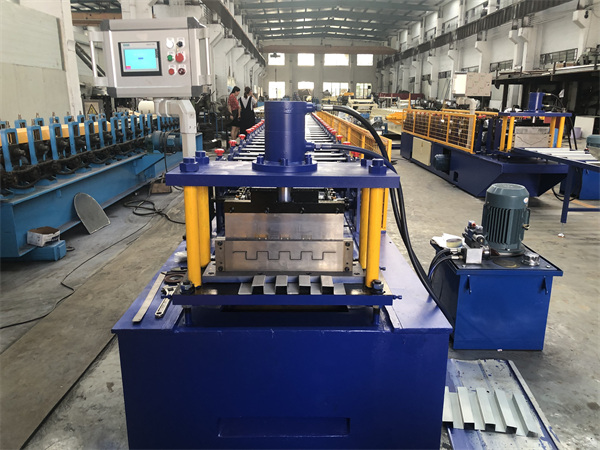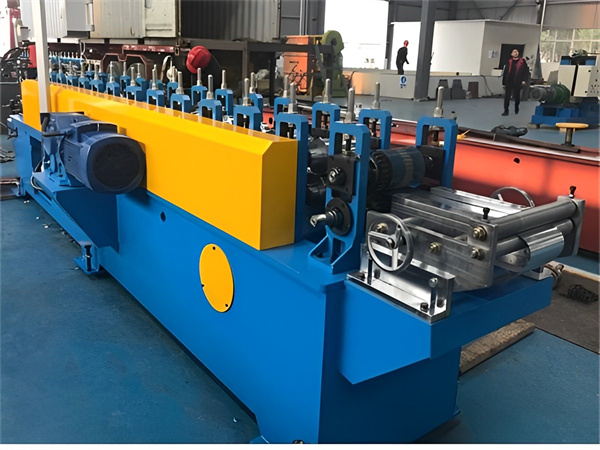1 परिचय
In the world of metal fabrication, efficiency, precision, and cost-effectiveness are paramount. To meet these demands, advanced machinery plays a pivotal role. One such innovation that has revolutionized the metalworking industry is the Angle Iron Roll Forming Machine. This article delves into the working principle, types, advantages, applications, maintenance, safety, and future trends of this remarkable equipment.
2. What is an Angle Iron Roll Forming Machine?
An Angle Iron Roll Forming Machine is a specialized piece of equipment used in the metalworking industry to transform flat metal strips or coils into angle iron profiles of various shapes and sizes. The machine achieves this through a continuous roll forming process, where the metal strip is passed through a series of roller dies, gradually forming it into the desired angle profile.

3. How Does an Angle Iron Roll Forming Machine Work?
3.1 Feeding and Straightening
The process starts with feeding the metal strip or coil into the machine. The strip is then straightened to ensure a consistent input for the roll forming process.
3.2 Roll Forming Process
Once the strip is straightened, it goes through a series of rollers, each responsible for bending and shaping specific parts of the angle profile. The rollers are carefully designed to progressively form the metal strip into the desired shape.
3.3 Cutting and Shearing
After the roll forming is complete, the continuous length of the angle profile is cut into individual pieces of the required length using a cutting or shearing mechanism.
3.4 Stacking and Packaging
Finally, the finished angle iron pieces are stacked and packaged for further processing or direct delivery to customers.
4. Types of Angle Iron Roll Forming Machines
There are three main types of Angle Iron Roll Forming Machines:
4.1 Single-Machine Angle Iron Roll Forming
This type of machine performs all the roll forming operations in a single unit, making it suitable for smaller production volumes and limited space.
4.2 Continuous Angle Iron Roll Forming
Continuous roll forming machines consist of several units, each dedicated to a specific bending operation. The metal strip passes through these units in a continuous flow, resulting in a high production speed.
4.3 Duplex Angle Iron Roll Forming
Duplex machines have two independent roll forming lines, allowing for the simultaneous production of two different angle profiles. It is ideal for large-scale production with diverse product requirements.
5. Advantages of Using Angle Iron Roll Forming Machines
The utilization of Angle Iron Roll Forming Machines provides several advantages:
5.1 Cost-Effectiveness
Roll forming is a highly efficient process that minimizes material waste, reducing production costs significantly.
5.2 Customization Options
Angle Iron Roll Forming Machines can be tailored to produce a wide range of angle profiles, meeting specific customer requirements.
5.3 High Production Speed
Continuous roll forming ensures a continuous production flow, enabling high-speed manufacturing of angle iron profiles.
5.4 Reduced Material Waste
Precision engineering and continuous forming reduce material wastage, making it an environmentally friendly option.

6. Applications of Angle Iron Roll Forming Machines
Angle iron profiles find diverse applications in various industries:
6.1 Construction Industry
Angle iron profiles are extensively used in construction for framing, support structures, and architectural elements.
6.2 Electrical Industry
The electrical sector utilizes angle iron profiles for manufacturing electrical enclosures, cable trays, and support brackets.
6.3 Automotive Industry
Angle iron profiles serve as critical components in vehicle frames and chassis.
6.4 Furniture Industry
Furniture manufacturers incorporate angle iron profiles in the production of sturdy and durable furniture pieces.
7. Factors to Consider When Choosing an Angle Iron Roll Forming Machine
Selecting the right machine for your specific needs requires considering various factors:
7.1 Material Thickness and Width
Choose a machine that can handle the material dimensions required for your angle profiles.
7.2 Forming Speed
Evaluate the forming speed to ensure it aligns with your production requirements.
7.3 Roll Tooling Design
The design of the roll tooling impacts the precision and quality of the formed angle profiles.
7.4 Automation Features
Look for automation capabilities to enhance efficiency and reduce manual labor.

8. Maintenance and Troubleshooting Tips
To ensure smooth operations and minimize downtime, follow these maintenance and troubleshooting guidelines:
8.1 Regular Inspection and Cleaning
Frequent inspections and cleaning of the machine components are essential to prevent debris buildup and potential damage.
8.2 Lubrication and Greasing
Proper lubrication of moving parts prolongs the machine’s lifespan and improves performance.
8.3 Common Issues and Solutions
Familiarize yourself with common problems and their solutions to troubleshoot efficiently.
9. Safety Precautions for Operating an Angle Iron Roll Forming Machine
Prioritize safety during machine operation:
9.1 Training and Certification
Ensure that operators are well-trained and certified to operate the machine safely.
9.2 Proper Machine Guarding
Install appropriate safety guards to prevent accidents and protect operators.
9.3 Personal Protective Equipment (PPE)
Mandate the use of personal protective equipment, such as gloves and safety goggles, to minimize risks.
9.4 Emergency Stop Procedures
Establish clear and accessible emergency stop procedures to halt operations in case of any unforeseen emergencies or malfunctions.
10. Future Trends in Angle Iron Roll Forming Technology
As with any industrial sector, technology continues to evolve, bringing innovative advancements to angle iron roll forming machines:
- Advanced Material Compatibility: Future machines may be designed to handle a broader range of materials, including advanced alloys and composites, expanding the application possibilities.
- Integrated Automation: Automation will likely become more sophisticated, enabling seamless integration with other manufacturing processes and reducing manual intervention.
- Enhanced Precision: Manufacturers may focus on improving the precision of roll forming to meet increasingly demanding quality standards.
- Energy Efficiency: Expect future machines to incorporate energy-efficient features, promoting sustainability and cost savings.

11. Conclusion
The Angle Iron Roll Forming Machine has emerged as a game-changer in the metalworking industry, revolutionizing the way angle iron profiles are produced. Its cost-effectiveness, versatility, and high production speed make it a valuable asset for various industries. However, successful implementation requires careful consideration of factors such as material compatibility, roll tooling design, and safety precautions. As technology continues to progress, angle iron roll forming machines will continue to be at the forefront of metal fabrication, delivering efficiency, precision, and sustainability.
12. FAQs
- What is the main purpose of an Angle Iron Roll Forming Machine? The main purpose of an Angle Iron Roll Forming Machine is to transform flat metal strips or coils into angle iron profiles of various shapes and sizes through a continuous roll forming process.
- What types of Angle Iron Roll Forming Machines are available? There are three main types of Angle Iron Roll Forming Machines: single-machine, continuous, and duplex, each catering to different production requirements.
- What industries benefit from using angle iron profiles? Angle iron profiles find applications in diverse industries, including construction, electrical, automotive, and furniture manufacturing.
- How does continuous roll forming differ from single-machine roll forming? Continuous roll forming uses multiple units for different bending operations, ensuring a continuous flow of production, while single-machine roll forming performs all operations in a single unit.
- Why is precision important in angle iron roll forming? Precision ensures the production of high-quality angle iron profiles that meet specific customer requirements and industry standards.
